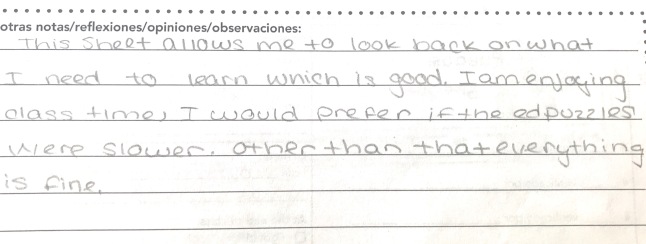Continuing today with the ongoing series of posts of structures I use in my classes to support student learning and teacher sanity–this time with a follow up. You can see more of this series here, here, here, here, and here.)
The first post in this series introduced the idea of merging Puedos a la Sra. Spanglish with a warm up tracker from Meredith White. With Meredith’s permission, I played around with the formatting and layout of the sheet to make it even more versatile. Find the handout here. One of the things that caught my eye on her original document was the reflection section that students complete at the end of the week.
Since my classes are on an A/B schedule, it takes us two weeks to use a whole sheet–even more if you have a hurricane like we did. As a result, I just got the first round of reflections from this year’s level 2 students and they are powerful. I asked them to respond to our standard feedback prompts:
- What’s going well for you in this class?
- What would make it even better?
- What can I do to support you?
Their honesty and thoughtfulness is impressive. Here’s a sampling:

Such helpful feedback for me. Slower EdPuzzles? Check. We will work on listening strategies, as well as the reminder that you can listen to EdPuzzle segments as much as you need.

Yay! How can I help? Aww, thanks.

I’m swooning over “talk & learn the language”. Another comment on EdPuzzle speed reinforces that we need to work on strategies… and that this particular video may have pushed the limits of their current skills.

More encouragement that we are on the right track. And that they miss Señor Wooly.

Some just get straight to the mero mero.

And this student’s response breaks my heart. I’m so honored that she feels comfortable sharing the group work comment with me. And here’s the thing: I didn’t know. But this information has already shaped my planning for we will do in the next class to help plug her in.
Reading through their comments has been so helpful for me. The vast majority have reported that they are on track. Several reached out for help, and there were a few that really caught my eye as needing some TLC.
I commented on each paper, returning the feedback favor, and have planned a few things to respond to their requests.
- I used a Remind app message to send a link to our Quizlet vocab set as a response to the multiple requests for extra vocab support.
- We’ll work on some listening strategies and I’ll choose a video with a little slower speed for next week.
- Señor Wooly was already in my plans, but I’ll present it as an “audience request” 😂
- But most important of all: I’ll be working extra hard to connect with the talented, hard working girl who shared that she doesn’t feel connected to her class. I’m so glad I asked, and so grateful that she shared.
Re: Hurricane Florence… My immediate community is in pretty good shape, but we are hosting evacuation shelters for people from the coast who are not. Our coast got hit, and HARD. Here are two ways to help groups that are doing amazing work on the ground here and at the coast:
- World Central Kitchen is feeding and delivering hot, delicious meals to thousands of people every day–evacuees, first responders, and families who have run out of access to food. This organization was founded by Spanish native Chef José Andrés and has an amazing model for disaster recovery. They are collaborating with FEMA and the American Red Cross and are getting the job done. I volunteered with them over the weekend, and their program is impressive.
- The American Red Cross has put out a special call for blood donations in addition to monetary donations. You do not need to be local to NC to help this way.




